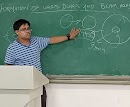Standard Model
A Crisped Introduction of Standard Model of Particle Physics
People
in earlier times often thought that what will happen if we go on dividing an
object to infinite level then what will happen?? What we will get??
Yeah,
we are still finding the answer to this question. Big research organisation
like CERN and BHABHA atomic research centre are working continuously to find
the answers. For now, what we have got is just a drop in the ocean. There is
lot to find yet.
Firstly,
to answer this question Dalton proposed that atoms are the smallest level of a
material we can reach if we go o dividing it. Then after the discovery of
electron by J.J. Thompson changed our perception again. Discovery of proton by
E. Goldstein and discovery of neutron by James Chadwick forced us to change the
concept of fundamental materials. At that time it was considered that electron,
proton and neutron are the fundamental particles and there is nothing beyond
that.
 |
| J.J. Thompson |
But
as you know, science always has something to astonish us. Discoveries of quarks
and leptons again changed our perception of the fundamental particles. The quark model was independently proposed by
physicists Murray Gell-Mann and George Zweig in 1964.Quarks were
introduced as parts of an ordering scheme for hadrons, and there was little
evidence for their physical existence until deep inelastic scattering
experiments at the Stanford Linear Accelerator Centre in 1968.
 |
| Murray Gell-Mann |
Electron was the first lepton to be found. The
next lepton to be observed was the
muon, discovered by Carl D. Anderson in 1936, which was classified as
a meson at the time.
Then Bosons came into the picture. Bosons are those
particles which provides forces and interact with other elementary particles.
Bosons are name after Indian physicist Stayendra Nath Bose, for his
contribution toward its discovery. Bosons follow Bose-Einstein statistics.
 |
| Stayendra Nath Bose |
Even after all these discoveries, we couldn’t
complete the chart of standard model of particle physics. Still there was
missing a particle which can complete this chart. The quest of that one
particle came to an end in 2012 at Large Hadron Collider in CERN. That particle
was named as Higgs Boson which was named after physicist Peter Higgs who
proposed the mechanism of this particle in 1964 along with other five
scientists.
With all the 6 quarks, 6 leptons, 4 gauge bosons
and Higgs Boson our standard model gets completed. These all particles work
according to the rules of Quantum Mechanics and obeys the Quantum World. For
now, these are the smallest level of a material. But, no one can say what will
happen in future. Organisations like CERN are continuously researching to find
more new elementary particles. So, may be in the future we may find other
particles and make a new chart of elementary particles.
In my upcoming articles, I am going to explain each
one of these particles in detail so, don’t forget to subscribe to our website
and follow me on social media for updates…..
You can directly talk with me on Instagram
To meet more physics Enthusiasts please join our Facebook Page
To meet more physics Enthusiasts please join our Facebook Page
Also for latest updates of my posts join me on Twitter
Thanks for reading.....
See you next time!!!
-Ratnadeep Das Choudhury
Founder and Writer of The Dynamic Frequency













0 Comments